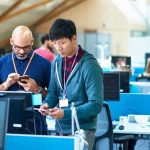Science, technology, engineering, and mathematics (STEM) disciplines are vital for fostering innovation, economic growth, and solutions to global challenges. However, many students still find STEM subjects difficult or unengaging.
How can STEM teachers adapt their instructional approaches to inspire interest and success? Here we will explore research-based techniques for delivering impactful STEM education.
Inquiry-Based and Discovery Learning
Having students actively investigate real-world problems develops critical thinking and scientific reasoning skills. As education reformer John Dewey stated, “Give pupils something to do, not something to learn.”
Inquiry-based learning immerses students in hands-on experiments, observations, and data analysis. The teacher acts as a guide, posing thoughtful questions, while students collaboratively discover knowledge.
Virtual lab simulations now enable inquiry remotely. Discussion of findings, patterns, and conclusions makes scientific concepts concrete. This inductive approach mirrors how science itself progresses.
Discovery learning similarly engages students in experience-driven investigations through modeling, roleplaying or case studies. Both inquiry and discovery foster deep conceptual understanding rather than just rote learning.
Project-Based Learning
Challenging students to apply STEM concepts to complete engaging, student-driven projects makes learning active and relevant.
Projects can involve designing apps or websites, constructing robots, developing consumer products, engineering solutions to problems, investigating local issues like water quality, and more. Students research, experiment, prototype, test, iterate, and present their work over an extended period.
According to research by Boaler, project-based learning raises STEM engagement, achievement and persistence among underrepresented groups by making connections to real needs and careers. Cross-disciplinary projects also strengthen problem-solving, teamwork and communication skills.
Game-Based Learning
Games introduce STEM concepts in motivating, low-risk contexts while enabling repeated experimentation and feedback.
Subject-specific games like Kerbal Space Program (physics and space science) and Cellcraft (cell biology) immerse students in realistic scenarios to master ideas experientially. Other games teach programming basics via puzzles and challenges.
According to studies by Ke and Grabowski, game-based learning improves attitudes toward STEM for both low and high achieving students. And it develops valuable systems thinking and problem-solving abilities.
Fun competitions and multiplayer games also engage students in peer learning and team collaboration. Game rewards and leaderboards incentivize practice. By making learning feel like play, games engage diverse learners.
Personalized and Adaptive Learning
Adjusting teaching to individual learners’ strengths and needs improves STEM success. Diverse methods for personalization include:
- Personalized learning plans with targeted goals based on performance data and interests
- Choice boards so students select differentiated activities matching their talents
- Flexible pacing and playlists allowing students to progress at their optimal speed
- Adaptive technologies that adjust content difficulty and teaching strategies to students’ needs in real-time
According to education technology expert Noora Fink, “Personalized learning tools help tailor STEM instruction and close skill gaps for each student.”
The optimal mix of whole class, small group, paired, and independent instruction accommodates different learning preferences. Student reflection also fosters metacognition and self-directed learning skills.
Culturally Responsive Teaching
Relating STEM to students’ cultural backgrounds and real-world contexts makes it more meaningful. Strategies include:
- Incorporating diverse scientists, inventors, and examples in course materials
- Aligning projects and problems with students’ lived experiences
- Promoting diverse communication styles and perspectives in the classroom
- Validating cultural knowledge and critiquing exclusionary norms and practices in STEM
- Developing mentorship programs and communities centering students of color
According to researcher Gloria Ladson-Billings, culturally responsive teaching “empowers students intellectually, socially, emotionally, and politically.” This fosters belonging and identity safety so students engage authentically with STEM.
Connecting STEM to Careers
Linking abstract concepts to real-world STEM careers ignites students’ passion and motivation by revealing relevant applications. Strategies include:
- Industry field trips and tours of local STEM companies
- Guest talks and panels featuring diverse STEM professionals
- Job shadowing programs partnering with STEM workplaces
- Real-world case studies and industry-sponsored competitions
- Career exploration and planning activities
“Students need to see how STEM classes provide the knowledge and tools needed for future careers,” says STEM education expert Dr. Heidi Schweingruber. Grounding learning in authentic applications sustains student engagement.
Leveraging Educational Technology
Digital tools expand instructional possibilities for STEM:
- Visualizations and simulations make abstract concepts concrete through 3D models, virtual experiments, and gamified scenarios
- Digital fabrication like 3D printing allows rapid prototyping of product designs for project-based learning
- Analytics dashboards provide real-time data on student performance to inform personalized instruction
- Adaptive learning platforms adjust teaching strategies and content to each student’s evolving needs
- Collaborative whiteboards and apps enable brainstorming, modeling, and team problem-solving
- Video demonstrations show experiments and applications students can replay at their own pace
“Technology infuses active learning and inquiry with higher engagement, creativity, and accessibility in STEM,” observes education futurist Karl Fisch.
Designing Effective STEM Assessments
Alongside instruction, STEM assessments must align with research on how students learn:
- Focus on conceptual understanding through projects, investigations, models, and application rather than just testing facts and procedures
- Emphasize competencies like critical thinking, teamwork, communication, and problem solving
- Incorporate self-evaluation and peer review to build metacognitive skills
- Provide actionable feedback tied to learning goals and strategies for growth
- Assess divergently with multiple ways for students to demonstrate proficiency like portfolios, presentations, labs, and designs
- Leverage technology for seamless formative assessments during instruction and to expand evaluation possibilities
According to education scholars Pellegrino and Hilton, “Next generation STEM assessments should foster, measure, and support deeper learning.” Aligned assessments catalyze student development.
Making STEM Accessible and Equitable
STEM teachers must also champion inclusion and equity:
- Scaffold instruction and provide accommodations to ensure all students can engage with STEM learning and demonstrate knowledge
- Address bias and barriers facing girls, students of color, multilingual learners, and students with disabilities
- Provide access to mentors and networks to open doors and counter stereotype threats
- Celebrate diverse examples and applications of STEM to build cultural belonging and identity safety
According to the National Science Teachers Association, “Inclusive STEM teaching practices make excellence accessible to all students.”
With evidence-based teaching strategies, technology integration, authentic assessments, and an equity mindset, STEM educators can unlock learning and unleash potential for all.


















